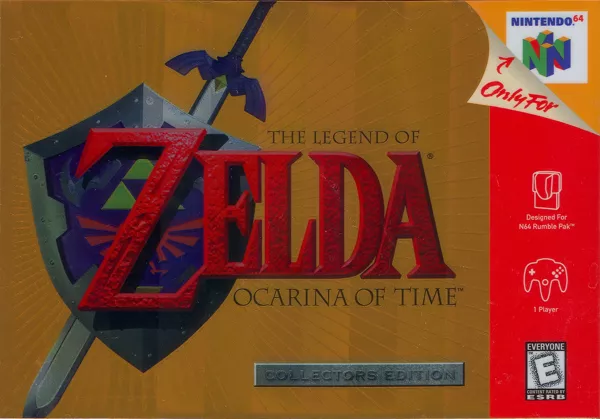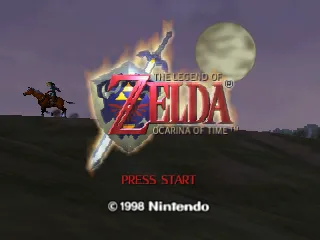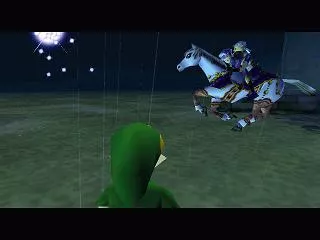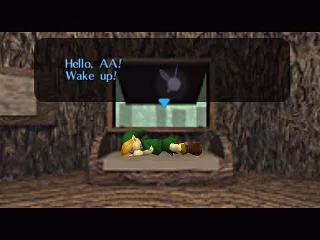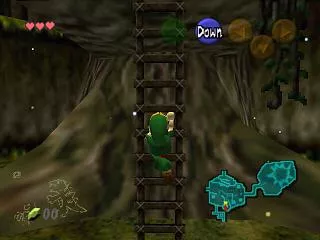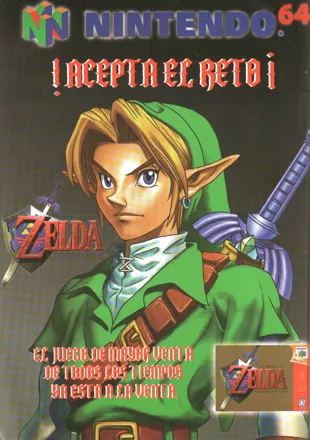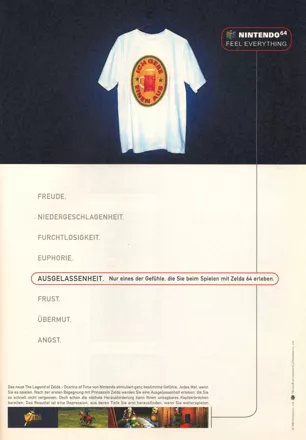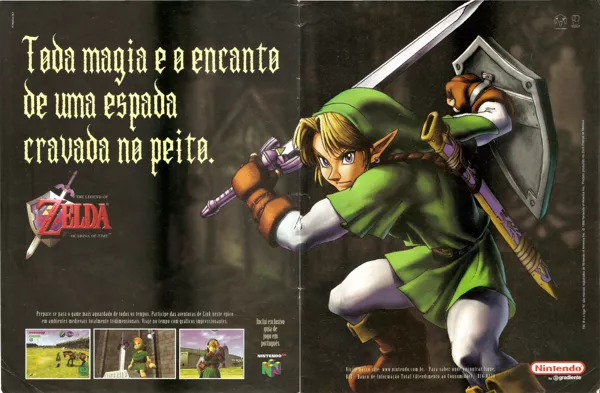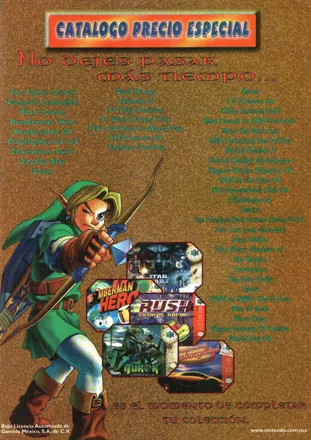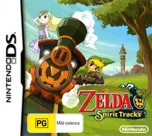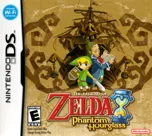The Legend of Zelda: Ocarina of Time
Description official descriptions
A young boy named Link was raised in the village of the elf-like Kokiri people. One day a fairy named Navi introduces him to the village's guardian, the Great Deku Tree. It appears that a mysterious man has cursed the tree, and Link is sent to the Hyrule Castle to find out more. Princess Zelda tells Link that Ganondorf, the leader of the Gerudo tribe, seeks to obtain the Triforce, a holy relic that grants immense power to the one who possesses it. Link must do everything in his power to obtain the Triforce before Ganondorf does, and save Hyrule.
Ocarina of Time is the first 3D installment of the Legend of Zelda series. Like most of its predecessors, it is an action game with puzzle-solving and light role-playing elements. Gameplay is similar to the previous games, allowing Link to explore the world and complete dungeons to obtain key items and advance the plot. Sword combat as well as many familiar items such as boomerang, bombs, the series' currency (rupees) of various values, heart containers, and their collectible fragments permanently increasing Link's health, etc., return in this installment. Link can now lock on enemies for melee and ranged combat, actively use a shield to deflect projectiles, as well as use various magic items. Dungeon exploration is somewhat more puzzle-oriented than in earlier games. Link can climb certain surfaces, dive underwater, as well as automatically jump.
The game begins with the player controlling the child Link, but later on, an adult Link becomes a playable character as well. Each of them has certain unique abilities: for example, only adult Link can use a bow and arrows, but only the child Link can crawl through narrow spaces. During the course of the game, the player obtains the Ocarina of Time. Learning and playing melodies on that ocarina is needed to advance the plot, complete certain side quests, or travel in time, switching between the two versions of Link. It is also possible to befriend and ride a horse named Epona to facilitate travel between areas.
Spellings
- ゼルダの伝説 時のオカリナ - Japanese spelling
Groups +
- Console Generation Exclusives: Nintendo 64
- Game Center CX challenge games
- Gameplay feature: Aging
- Gameplay feature: Auto-mapping
- Gameplay feature: Day / night cycle
- Gameplay feature: Drowning
- Gameplay feature: Equipment quick slots
- Gameplay feature: Fishing
- Gameplay feature: Horse riding
- Games made into books
- Games referenced in movies
- Legend of Zelda series
- Nintendo Player's Choice releases
- Protagonist: Elf
- Setting: Inside a giant creature
- Theme: Time travel
Screenshots
Promos
Videos
See any errors or missing info for this game?
You can submit a correction, contribute trivia, add to a game group, add a related site or alternate title.
Credits (Nintendo 64 version)
76 People (66 developers, 10 thanks) · View all
| Executive Producer | |
| Producer | |
| Director | |
| Program Director | |
| Chief Programmer | |
| Main Program | |
| [ full credits ] | |
Reviews
Critics
Average score: 97% (based on 81 ratings)
Players
Average score: 4.2 out of 5 (based on 428 ratings with 17 reviews)
One of the most Overrated games of all.
The Good
OOT is held in high regard by all Zelda fans as the best game is the series. While it certainly one of the better games in the franchise, it's far from the best. The graphics, at least in 1998, were top-notch. The world of Hyrule is colorful and detailed, making exploring the land even more enjoyable. The music is equally phenomenal, with the game having memorable Zelda tunes such as the Song of Storms and Zelda's Lullaby. The gameplay's high note is the playability of the game, having a workable (yet flawed) control scheme, a decent-sized overworld, and fun, yet complex dungeons, featuring somewhat easy puzzles (with a few exceptions) and a pretty cool storyline for the time.
The Bad
While the game is mostly a fantastic game, but it's quite flawed. The biggest issue with the game is the camera. I understand that it really was the first 3D Zelda game, but time has been harsh to OOT, especially with The Wind Waker gracing the GameCube. You will be fighting the camera alot, constantly recentering it and wrestling with it to get it where you want it to go. Another is how the items work. In some dungeons, you are required to switch between alot of your items in your inventory, leading to some tedium. The game is a little on the easy side, I had little trouble completing the game within about a whole day. The puzzles can be hard, but the combat is very simple, involving you blocking, attacking, and then blocking again. Not much strategy involved, of course. Epona, your horse, has little use except for fast travel which is important for certain side-quests, making the stupidly easy race to get her basically a waste of time.
The Bottom Line
Now, I'm not saying that OOT is a bad game, on the contrary, it's a fantastic game that you must play, but it is NOT the best game in the Zelda series, and it certainly isn't the best game ever. It really is a amazing game that you'll absolutely love, but you probably won't call it the best game around, especially when A Link to the Past and The Wind Waker available. A great game? Certainly. Best game ever? I just don't think so.
Nintendo 64 · by JohnLennon224 (13) · 2010
The Good
The first time I played this game and I saw the graphics I was stunned. When you start in Kokiri forest and you can see things flying through the air you can pretty much smell the dew on the leaves. The idea that you could go between adult Link and child Link was good also, it was like having two games in one. This is, in my opinion the best of all the Zelda games except for maybe the nintendo ones which are just classics.
The Bad
The only two things that annoyed me about this game was that there were about 4 towns and all together there were about 35 NPC's at the most, so there was not an extreme amount of interaction. And the fact that they show you this big castle that looks beautiful from the outside and you never actually get to go into the castle until it gets taken over by Ganondorf was quite disappointing.
The Bottom Line
In you have played any of the other Zelda games then this game is a definite must. I saw the graphics of the Gamecubes new Zelda : Windwaker i think it was called because I looked at the graphics and it just put me right off. I think this game is well worth playing if you have the time to go through it.
Nintendo 64 · by Horny-Bullant (49) · 2003
The Good
The most important aspect of any adventure game is that playing it actually feels like going on an adventure and that is what Ocarina of Time nails perfectly. As I fight your way through temples, go on side-quests and explore the beautiful Hyrule Field I always feel this unique feeling that feels like a mix between excitement, determination and a slight bit of fear. I haven't played any other game, not even within the adventure genre that has made me feel exactly the same.
Another interesting thing this game managed to do was making me care a lot about Hyrule and those who lived in it. I first noticed this very clearly when I had to return to my childhood as part of a temple (thus going back to Hyrule before it got ruined) and I just had to visit a few locations to check up on them. I wanted to hear their cheerful theme songs and watch the people in those places wander around carelessly before I would go on with my adventure. The whole time travel fiasco was used in a very good way to give the story some emotional weight.
The characters are also very good, not because they have some brilliant writing to back them up, but because their physical design is very appealing and they are very friendly or have interesting personalities. Nintendo has never been too good at handling their stories and characters arcs very well, but Ocarina of Time keeps it rather simple and benefits because of that choice. Saria, Malon, Darunia and all the others became some of the most popular characters in video games history and they got quite a cult following behind them.
What this game is remembered the most for is its amazing soundtrack and the way it was implemented into gameplay; A few times throughout the game you will have to rely on the soundtrack to help you solve a puzzle, but the most common use is the Ocarina, which allows you to play a few songs in order to use the magical powers they contain. Using songs you can teleport to locations all over the world, call your horse, trigger events during puzzles or open up parts of the map that are off-limits.
There are moments in the game where Nintendo really reached out to the veteran players, old fans who have been with the franchise since they were kids in the 80's, but have now grown up into adults. A certain temple that showcased Hyrule's dark and gruel past is perhaps the best exception, but there is also some well implemented sexual innuendos hidden here and there and a few very good character lines and rhymes that always made me feel like I was receiving a little present.
Even though this imagery and adult stuff is around, the game still manages to keep it mostly kid friendly, having the innuendos pass way over their head and not going too far with the darker style of the second half of the game. By doing so and maintaining a very well structured difficulty curve they managed to make this game both child/family friendly and add another great title to the family console everybody remembers as the Nintendo 64.
The puzzles are very good and they proved to be amusingly challenging without reaching the point where you just shrug it and boot look up a walkthrough (although I had to do that once or twice). Repetition is kept to a minimum which is also very nice and like always you are required to make creative use of your items and weapons in order to solve them.This format has proven quite successful, but this is the Zelda game were it worked out the best.
The Bad
The graphics haven't aged very well and the way the world is presented is rather shabby. 90's polygon graphics are one of those things from the past you look back at and feel slightly ashamed off, but it's the presentation that worries me the most. Very little effort has been put into making the world feel like a living whole and that already becomes obvious when you first arrive in the first area and see a whole race of children sitting around in one spot, constantly repeating a single animation. Those kids should be playing and laughing, don't have them just sit there and occasionally talk to you.
It is also quite annoying that the character Link is kind of a boring tool, not any more interesting then a kitchen knife and functioning almost exactly the same. He barely ever shows any emotion at all except for whenever he does something that astounds himself (like learning a song). There is a memorable scene very early on where he leaves his home village and says farewell to his childhood friend, but as she empties her hearth, Link suddenly backs off in a way that makes it looks like he is cowering away from the possible emotional response he feels coming. A lot of characters do the same, but Link just takes the crown for this kind of uncanny behavior.
I am sure we can all agree that Nintendo 64 controllers were never really good with smooth controls. Most controllers have a terrible analog stick, but even if they don't it sometimes feels like playing R.C. Pro-Am, where you switch between different directions instead of a smooth 1:1 response. This is especially annoying during moments where you need to platform around dangerous areas such as the Fire Temple. There was one point where I had to walk over a very narrow path within a short time limit where falling to the right would place me back at the start of the dungeon, this part will be remembered among networking classes as situations that just never seemed to end.
Talking about the temples, there is a bit of a problem with those two. In the sense that I am wondering how many more times I am going to have to play through a series of temples/dungeons that use the elements as their themes. The one thing I learned from Psychonauts is that a game becomes much more easier when you base key areas around something else, in that games' case around the physiques of the people you met during your adventure. Another problem is that the game is a little too eager to tell you about their clever ideas, such as how they used people you met during the the first part of the game Sages in the second half, but this means the game almost always spoils who the next sage is going to be before you enter the temple. That stuff should be an interesting mystery up until the point you finally find out who it is.
By doing a very annoying side-quest you can unlock a two-handed sword that for some reason does more damage than the Master Sword. Not to ruin your clever ideas Nintendo, but combined with the overall story this is just a really dumb idea because it causes the story about the legendary blade trip and break it's skull on a rock. Why would you put a weapon in the game that is better than the one of legends you can't stop banging on about in this series? Go sit in the corner, you're staying after class Nintendo.
The Bottom Line
Having replayed Ocarina of Time has been an interesting experience to me, on one hand I discovered the many rocky mistakes that slipped past me the first time around, but on the other hand I also noticed a lot of great things that I missed just because I was too absorbed into the story. Overall though, the balance between good and bad things hasn't changed in my opinion, though I still look at this game from a very different perspective now.
As I mentioned before, Ocarina of Time is a game for a lot of people; the hardcore crowd will enjoy it's great gameplay and action scenes, the Zelda fans will love it for some of the mature themes it has and the improvements it has brought into the series, the casual/family members will enjoy the excitement of a big adventure on the Nintendo 64 and the kids will simply love the style and mystery that surrounds this title.
Nintendo 64 · by Asinine (957) · 2011
Discussion
| Subject | By | Date |
|---|---|---|
| Am I the only one? | GAMEBOY COLOR! (1990) | Jul 15, 2012 |
| Beta screenshots ? | GAMEBOY COLOR! (1990) | Jun 13, 2009 |
Trivia
1001 Video Games
The N64 version of The Legend of Zelda: Ocarina of Time appears in the book 1001 Video Games You Must Play Before You Die by General Editor Tony Mott.
Development
The Legend of Zelda: Ocarina of Time started life in development for Nintendo's 64DD add-on for the Nintendo 64 (which was a disk drive that was only released in Japan with little fanfare). The 64DD flopped in Japan and it wasn't even released in the USA. As a result, this game, instead of being released in disks, was crammed into a cartridge (which was the biggest N64 pre-Expansion Pak cartridge released, in terms of space). Even though it was originally developed and planned for the 64DD, it was announced to much surprise that Zelda would release in cartridge form for the N64 first; further indicating that the disk drive platform was not gaining the traction Nintendo had hoped for.
Cartridge
Due to overwhelming fan requests, Nintendo decided to release the original production releases of the game as a gold-colored cartridge, restoring the 'golden cartridge' lineage that had previously been broken by the SNES version of The Legend of Zelda: A Link to the Past, and The Legend of Zelda: Link's Awakening for Game Boy.
Versions
There are at least three different versions of the game: 1.0, 1.1 and 1.2. The golden (limited edition) carts, as well as some gray carts, are all 1.0. The majority of the ordinary gray carts are 1.1, and many of the later produced ones are 1.2.
The only notable change between 1.0 and 1.1 is that the Fire Temple music was changed a little bit. It had a chant from an Islamic prayer looped in the background which offended some members of the Islamic community. 1.1 also fixed some bugs, the most famous of them being the sword-losing bug. In 1.0, if the player saves the game in the end battle after losing the Master Sword, and restart the game, they don't have the sword anymore, but they can use all items while riding Epona. Also the final boss originally had red blood which was changed to green in a later version.
Fan remake
Daniel Barras was making a PC fan remake of the game, titled Ocarina of Time 2D. Basically, this was to be a remake with all of the story, areas, creatures and items from The Legend of Zelda: Ocarina of Time, using graphics similar to The Legend of Zelda: A Link to the Past. Regrettably, Nintendo was not very happy about this (or any other Zelda remakes that use The Legend of Zelda: A Link to the Past sprite rips), so the project is gone now.
Stone of Agony
The Stone of Agony allows players to feel a rumble to find hidden areas. This of course only works if they have a rumble pack accessory attached to their N64 controller (or are playing the Gamecube version). For the Wii Virtual Console version, this feature has been disabled.
Left-handedness
Link has always been left-handed, but it is particularly noticeable starting with this game. In the original title, this wasn't always noticeable due to sprite-flipping techniques. The reason for Link's left-handedness is that his creator, Shigeru Miyamoto, is also left-handed.
Voice acting
Voice acting for the adult Link was done by Nobuyuki Hiyama, who also did the voice acting for Link in Super Smash Bros. The person who did the voice of Link as a child, Fujiko Takimoto is a woman. This explains Link's extremely high voice.
Ad controversy
An advertisement for Ocarina of Time shown in British TV proved to be controversial. Using the slogan "Willst thou get the girl? Or play like one?", the ad provoked complaints to the Independent Television Commission from viewers who considered it sexist. ITC however ruled against taking the ad off the air, stating that "such tongue-in-cheek treatments were unlikely to have the widespread negative affect that those who complained feared."
References: Zelda series
- Many of the character names, such as Rauru, Mido, Ruto, Saria, and Darunia, are actually names of towns in
Zelda II: The Adventure of Link . - The characters Malon and Talon are based on Marin and Tarin from The Legend of Zelda: Link's Awakening. Marin was a Zelda lookalike who also had a beautiful singing voice.Tarin was her father and had a liking for mushrooms (he resembled Mario).
References
- Both Talon and his assistant Ingo resemble Mario and Luigi, although it's interesting to note that they have an antagonistic relationship. Both Talon and Malon wear medallions that are shaped like Bowser's head.
- Looking through the windows of Zelda's Castle, players can see pictures of Mario, Bowser and other
Super Mario Bros. characters adorning the walls. - When using a GameShark, the player can make Arwings appear that will attack Link. The Arwing is the primary spacecraft of the
Star Fox series . - The horse in the game is named after the Celtic horse goddess, Epona.
- The lantern-carrying ghosts called Poes are named after the famous horror writer
Edgar Allan Poe . - In the Forest Temple the player encounters the four Poe sisters: Joelle, Beth, Amy, and Meg. They are named after the four protagonists of the novel Little Women by
Louisa May Alcott .
Awards
- EGM
- February 2006 (Issue #200) - #8 out of 200 of the "Greatest Games of Their Time" list
- Game Informer
- August 2001 (Issue #100) - #11 on the "Top 100 Games of All Time" poll
- GameSpy
- 2001 – #43 Top Game of All Time
- Nintendo Power
- Issues #196-200 - #1 "Top 200 Nintendo Console Games of All Time"
- Retro Gamer
- October 2004 (Issue #9) – #5 Best Game Of All Time (Readers' Vote)
- WatchMojo
- August 2014 - ranked #1 in the Top 10 Video Games of All Time
- The Strong National Museum of Play
- 2022 – Introduced into the World Video Game Hall of Fame
Information also contributed by Andrew Shepard, Attila, Big John WV, festershinetop, Guy Chapman, Mark Ennis, Matt Neuteboom, ModestMr.Green, Tiago Jacques, WildKard, and WWWWolf.
Analytics
Upgrade to MobyPro to view research rankings!
Related Sites +
-
OC ReMix Game Profile
Fan remixes of music from The Legend of Zelda: Ocarina of Time. -
The Legend of Zelda: Ocarina of Time/Master Quest
Nintendo of America's official web site for the GameCube version. -
Zelda 64 Fan Site
A fan site dedicated to the Nintendo 64 Legend of Zelda -
Zeldapower.com Forums
Message Boards for all of the Zelda games
Identifiers +
Contribute
Are you familiar with this game? Help document and preserve this entry in video game history! If your contribution is approved, you will earn points and be credited as a contributor.
Contributors to this Entry
Game added by Kartanym.
Wii U added by Michael Cassidy. Nintendo Switch added by Rik Hideto. Wii added by Sciere.
Additional contributors: PCGamer77, Jeanne, Joshua J. Slone, gamewarrior, Havoc Crow, BobaMa, Cantillon, Arejarn, Patrick Bregger, Thomas Thompson, FatherJack, John H., WONDERなパン, SoMuchChaotix.
Game added April 3, 2001. Last modified March 11, 2024.
